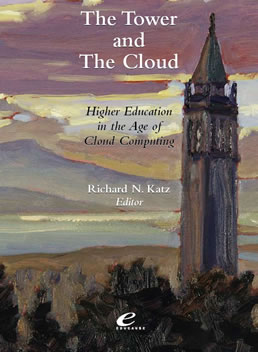The Tower and The Cloud

The emergence of the networked information economy is unleashing two powerful forces. On one hand, easy access to high-speed networks is empowering individuals. People can now discover and consume information resources and services globally from their homes. Further, new social computing approaches are inviting people to share in the creation and edification of information on the Internet. Empowerment of the individual—or consumerization—is reducing the individual's reliance on traditional brick-and-mortar institutions in favor of new and emerging virtual ones. Second, ubiquitous access to high-speed networks along with network standards, open standards and content, and techniques for virtualizing hardware, software, and services is making it possible to leverage scale economies in unprecedented ways. What appears to be emerging is industrial-scale computing—a standardized infrastructure for delivering computing power, network bandwidth, data storage and protection, and services. Consumerization and industrialization beg the question "Is this the end of the middle?"; that is, what will be the role of "enterprise" IT in the future? Indeed, the bigger question is what will become of all of our intermediating institutions? This volume examines the impact of IT on higher education and on the IT organization in higher education.
Richard N. Katz, Editor
©2008 EDUCAUSE ISBN 978-0-9672853-9-9
View Entire Book in PDF
Table of Contents
Foreword
by Diana G. Oblinger
PDF | HTML
Preface
by Richard N. Katz
PDF | HTML
Higher Education and Information Technology
The Gathering Cloud: Is This the End of the Middle?
by Richard N. Katz
PDF | HTML
A Matter of Mission: Information Technology and the Future of Higher Education
by Clifford A. Lynch
PDF | HTML
The University in the Networked Economy and Society: Challenges and Opportunities
by Yochai Benkler
PDF | HTML
The Globalization of Higher Education
Growing in Esteem: Positioning the University of Melbourne in the Global Knowledge Economy
by Glyn Davis, Linda O’Brien, and Pat McLean
PDF | HTML
Higher Education and the Future of U.S. Competitiveness
by David Attis
PDF | HTML
Accountability
The Social Compact of Higher Education and Its Public
by Larry Faulkner
PDF | HTML
Accountability, Demands for Information, and the Role of the Campus IT Organization
by Brian L. Hawkins
PDF | HTML
IT Governance
E-Research Is a Fad: Scholarship 2.0, Cyberinfrastructure, and IT Governance
by Brad Wheeler
PDF | HTML
Beyond the False Dichotomy of Centralized and Decentralized IT Deployment
by Jim Davis
PDF | HTML
From Users to Choosers: The Cloud and the Changing Shape of Enterprise Authority
by Ronald Yanosky
PDF | HTML
Open Information, Open Content, Open Source
Cultural and Organizational Drivers of Open Educational Content
by Malcolm Read
PDF | HTML
Challenges and Opportunities of Open Source in Higher Education
by Ira H. Fuchs
PDF | HTML
Who Puts the Education into Open Educational Content?
by Andy Lane
PDF | HTML
Scholarship in a Cloudy World
The Tower, the Cloud, and Posterity
by Richard N. Katz and Paul B. Gandel
PDF | HTML
From the Library to the Laboratory: A New Future for the Science Librarian
by Mary Marlino and Tamara Sumner
PDF | HTML
Social Networking in Higher Education
by Bryan Alexander
PDF | HTML
Scholarship: The Wave of the Future in the Digital Age
by Paul N. Courant
PDF | HTML
Where Is the New Learning?
by Kristina Woolsey
PDF | HTML
Teaching and Learning Unleashed with Web 2.0 and Open Educational Resources
by Christine Geith
PDF | HTML
University 2.0
by John Unsworth
PDF | HTML
The Tower, the Cloud, and the IT Leader and Workforce
by Philip Goldstein
PDF | HTML
Afterword
by Andy Cooley
PDF | HTML
Copyright Information
Authors retain the copyright to their intellectual content, with EDUCAUSE owning the copyright to the collected publication.
Permission is granted to copy or disseminate the document, either in print or electronic format, if the following conditions are met:
- copies are not made or distributed for commercial advantage
- the EDUCAUSE copyright and its date appear on the reproduced materials
- notice is given that copying is by permission of EDUCAUSE